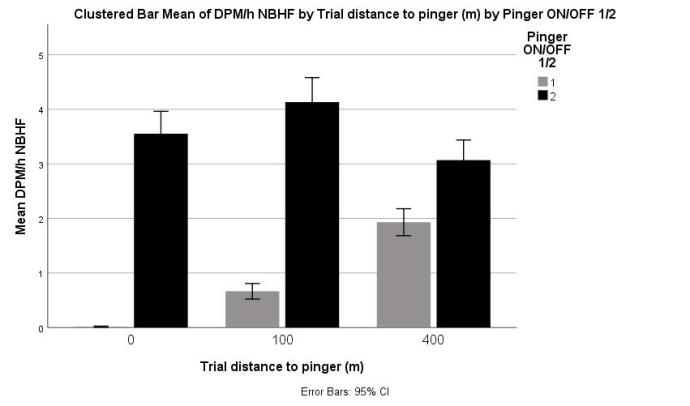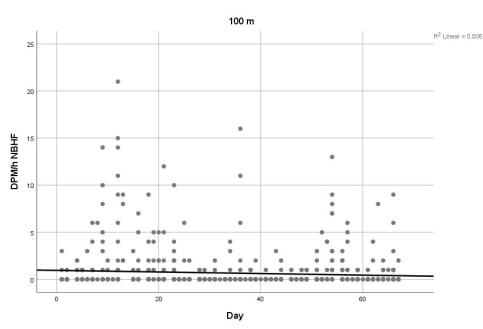Results
The pinger deterrent effect on harbour porpoises
The factors found to affect the DPM/h (how many minutes a porpoise was present per hour) was found to be:
- If the Banana pinger was ON or OFF
- The distance to the Banana pinger
- Time of the day
- Day after deployment
- The interaction between pinger ON/OFF and distance to pinger
- The interaction between time of day and day
Pinger ON/OFF and distance to pinger
A clear deterrent effect could be seen when looking at the interaction of pinger ON/OFF and distance to pinger. When the Banana pinger was ON the 0 m position C-POD recorded on average 0.001 DPM/h while when the pinger was OFF the C-POD recorded on average 3.55 DPM/h. At 100 m from the pinger there is still a large difference betwee pinger ON and OFF with mean values of 0.66 vs 4.13 DPM/h respectively. At 400 m the deterrent effect is not as clear with 1.93 DPM/h when the pinger was ON compared to 3.07 DPM/h when the pinger was OFF. This is rather expected since the porpoises cannot hear the pinger when they are too far away, the Banana pinger company (FishTek Ltd) themselves suggest to put the Banana pingers every 200 m on fishing nets.


Habituation
Looking at the DPM/h over the different days when the Banana pinger was ON I could exclude habituation to the pinger. No increase in DPM/h was found to be significant for any distance from the pinger over the 67 days of testing. On the picture to the right is the 100 m graph, but it looked similar for the 0 and 400 m positions as well.
Time of day
Interestingly, the trend of porpoise activity over the day differed slightly between pinger ON and OFF. When the pinger was OFF most DPM/h was during the early morning, dusk and late night. When the pinger was ON most DPM/h was instead during the dusk and midnight.

Responsible for this page:
Director of undergraduate studies Biology
Last updated:
06/01/18
